Budapest, an Historical City in Modern Times 1/7
Photo (hdm): Taken from a walkway just below the Buda Castle and overlooking the Danube toward the Parliament Buildings.
Introduction
Those new to reading posts on this blog will note many stories contain substantial social comment. This is less true in the Travelogue Section. While the sights and sounds of a new town, city or country are extremely interesting, what really piques my interest in the fabric of the society and the history of the people. Meeting young people is also important, as it is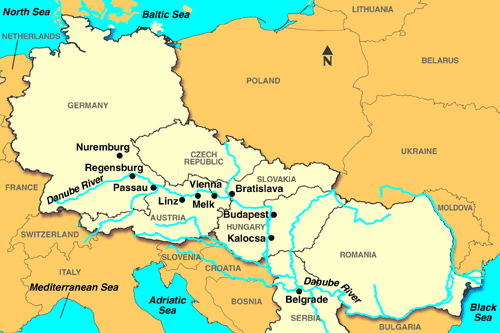 young people who will largely define how well a country will meet the challenges of the future.
young people who will largely define how well a country will meet the challenges of the future.
The experience of sailing up the Danube on the River Beatrice from Budapest, Hungary to Passau, Germany with stops in Slovakia and Austria, then overland to Prague in the Czech Republic, provided plenty of material upon which to comment. My impressions of how people have overcome the challenges experienced over the most recent century were overwhelmingly positive. It has never ceased to amaze me how the people of Europe, as mortal enemies in one decade or series of decades, have overcome their differences and become open, friendly trading partners in the next.
While part of the story of our travels will be presented in narrative form, photographs taken by Esther Dunn and myself (using identical Panasonic camera’s that we managed to mix up more than once) will be used to tell ‘the rest of the story.’ In a few instances, photos have been plucked from the Web in order to flesh out a storyline for those areas in which signs indicated “photography not allowed”. While I can normally overcome such instructions (these signs are usually posted for commercial reasons) I did manage to occasionally restrain myself. Each of the photos will be identified by the source.
Now to the stories of our travels along the Danube.
Budapest, a Historical City in Modern Times
From the moment we arrived in Budapest, we knew this trip was going to bring many special memories, memories that would leave us with a much greater appreciation of the challenges faced by those held under the thumb of a brutal regime as was the case for each of the five countries we visited: Hungary, Slovakia, Austria, Germany and the Czech Republic. It was a history that our land tour guides always tackled in a forthright manner.
In the taxi from the Airport to our hotel (at no less than warp speed) we were provided with an ever so ‘fleeting’ glimpse of what life must have been like living as one of the satellite states of the Soviet Union. Gray run-down factories and non-descript apartment buildings covered with graffiti, strung along broken fences and abandoned lots filled with rusting material. While this was certainly not indicative of the central city core where we would spend most of our days, it was a vivid reminder that Hungary has been free for barely 22 years after spending 45 years within the repressive Soviet Communist system.
As we approached the city centre and then crossed to the Buda side, it was a far different story. Our hotel, the Orion (Best Western), was located just below the Buda Castle and only steps away from the Danube. We had chosen this location as it provided easy foot access to the central city on both the Buda and Pest sides of the Danube, as well as easy access to our cruise vessel, the River Beatrice, which would dock less than half a block from our hotel.
Not long after making a post on Facebook, our soccer buddies and travel friends, Suzanne Flannigan and Joseph Calado (subjects in an upcoming post on “Iron Man” in Zurich), told us they had at one time lived in a small apartment just a few doors from our hotel.
After a few hours of exploring the city, two things about this country stand-out. First, the people, and second the history. Each step along the way, whether at the hotel, in a restaurant, at a tourist site or when chatting with people on the street, we found the Hungarians to be welcoming, friendly, optimistic people who were helpful in every way.
As I always enjoy stopping to chat with people along the streets, I spied a young couple having their photos taken on the terrace of a nearby building. It only took a few seconds to convince the photographer to join the couple and let me take a shot. Having subsequently become 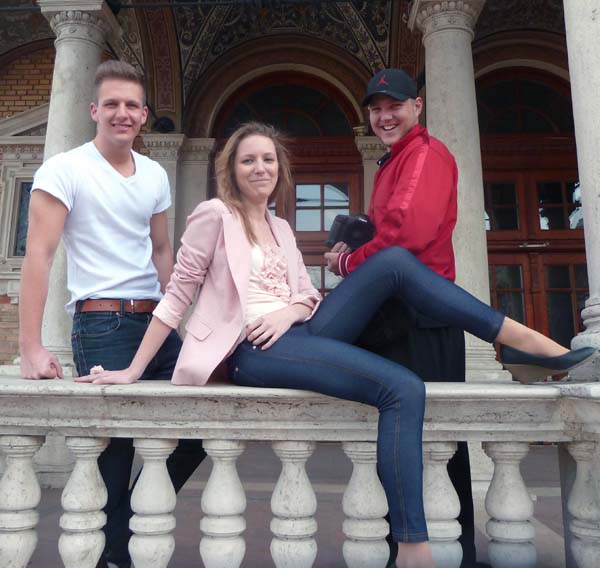 friends with the three on Facebook, I have learned the couple were, in fact, brother and sister, likely born sometime shortly after the Soviet occupation of Hungary ended and who now live close to the nearby town of Hollókő.
friends with the three on Facebook, I have learned the couple were, in fact, brother and sister, likely born sometime shortly after the Soviet occupation of Hungary ended and who now live close to the nearby town of Hollókő.
Photo (hdm): Barbara and Bálint (left) with photographer Tamas.
Later, during an exchange on Facebook, I asked Bálint about his thoughts on home and country. He stated:
Sure, I can tell you many things about my country! The Hungarians are friendly and kind, but also a bit loner yet we really like having fun.
I can say that my country is hardly centralized to Budapest, but in the countryside, you can find much nicer places! Villány and Eger are famous for their wine. Debrecen is the second biggest city in Hungary, an old and lovely city. I live not far from Hollókő, a small village famous for its traditional folk costume.
Here is a link: http://www.holloko.hu/
I hope I could help you. If you need more details, just ask me!
Looking forward to hearing from you.
Best wishes,
Bálint
This response was indicative of the people we met in Hungary. As for living outside the city, I recall one tour guide mentioning that nearly 1,000,000 people travel into Budapest each day to work or study. Barbara is currently preparing for an exam in Analytical Chemistry. Hmm, very pretty, and smart! As for the outgoing, happy young men, they could be Sean or any of his many friends. Hungary is certainly in good hands.
A bit more History
From 1537 – 1918, Hungry was held under the tight control of the Hapsburg Monarchy of Austria after the Kingdom of Hungary was enjoined. In modern times, after several years of suppression by the Third Reich, they faced an equally horrendous future. As part of the spoils of war their country was ceded to the Union of Soviet Soviet Socialist Russia (USSR) then under an infamous leader, Josep Vissarionovich Stalin (born Iosif Vissarionovich Dzhugashvili; 18 December 1878 – 5 March 1953), one of the most murderous dictators in history.
In 1956, in a desperate attempt to gain their freedom, the Hungarian people rose up in a popular revolution only to be brutally crushed by a vastly superior Soviet military machine whose officers and 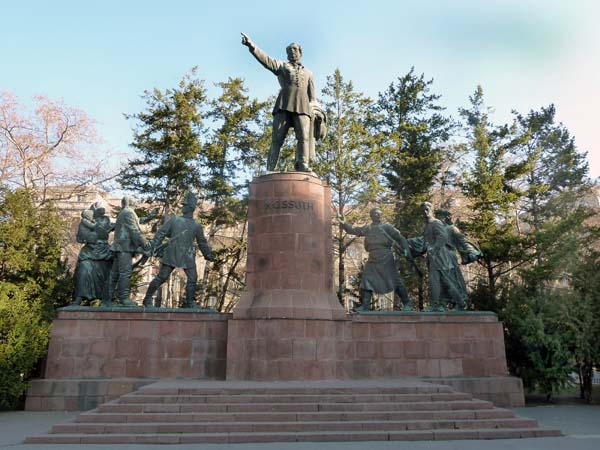 men showed no mercy to the Hungarian Freedom Fighters who had fought so valiantly.
men showed no mercy to the Hungarian Freedom Fighters who had fought so valiantly.
Photo (hdm): Statue on the grounds of the Hungarian Parliament commemorating Kossuth de Udvard et Kossuthfalva (19 September 1802 – 20 March 1894) a Hungarian lawyer, journalist, politician and Regent-President of Hungary in 1849. He was widely honoured during his lifetime, including in the United Kingdom and the United States, as a freedom fighter and bellwether of democracy in Europe (web source)
It was not until the USSR collapsed in the late 1980s, that the Third Hungarian Republic was formed on October 23, 1989. Over the past twenty-three years, the resilient Hungarians have worked to rebuild their country into the welcoming nation it has become today, a nation based upon the democratic principles.
These sombre facts are not meant to detract from the joy of touring the countries we will touch over the next two and one-half weeks, but simply to bring into focus what it means for people to live in a free and democratic society where the will of the people and rule of law is the force that drives the country and not the whims of an out of touch monarch or a brutal dictator.
For Lynn, Esther, Garth and me, we shall savour every moment as we soak up both the splendour and history of countries along the Danube from our home base aboard the River Beatrice.
Following are several photographs that provide a small sample of life in the city of Budapest. After hearing from our travel guide and doing more research, it is obvious we could spend many more days exploring the city and the country.
Footnote: Hungarian Freedom
200,000 fled the country with little more than the clothes on backs.
2,500 Freedom Fighters were killed and hundreds more injured
The heaviest resistance was in Budapest which was heavily targeted by Russian artillery and airstrikes.
26,000 Hungarians were brought before tribunals
22,000 sentenced and 13,000 imprisoned
350 were executed
Current Day Cost Perspective
(Prices translated to Canadian Dollar)
General
Gasoline (litre) $1.85
Pair of Levis $100
Pair of Nike $100
Theatre $8.00
Restaurant Dinner
Meal $7.00 – $15.00
Beer (domestic pint) $3.50 – $4.00
Wine $6.00 – $8.00
Cappuccino $2.00
Coke $1.50
Note: In a small, trendy restaurant just below the Buda Castle and near our hotel, the four of us had a light meal that included two pints of beer, a bottle of local wine and coffee. The total bill came to $55.00 Canadian. The restaurant staff were friendly and the service excellent. As we travelled we always felt we received good value. These costs were fairly average for all the countries through which we travelled. The economies in Austria and Germany, appeared to be more advanced, however, that would be expected given the advantageous position they have occupied since the end of World War II.
Given the medium monthly salary in Hungary (and similar in Slovakia and the Czech Republic) runs around $750, the living costs for the average working person would be high in comparison to Canada.
The Magic of Canal and River Travel
(A Photo Essay on Budapest Follows)
While travelling through England and Wales, as well as several countries on the European continent, Lynn and I were fascinated by the number of waterways that snake through the countrysides. Longboats of every type and size were parked right to the very 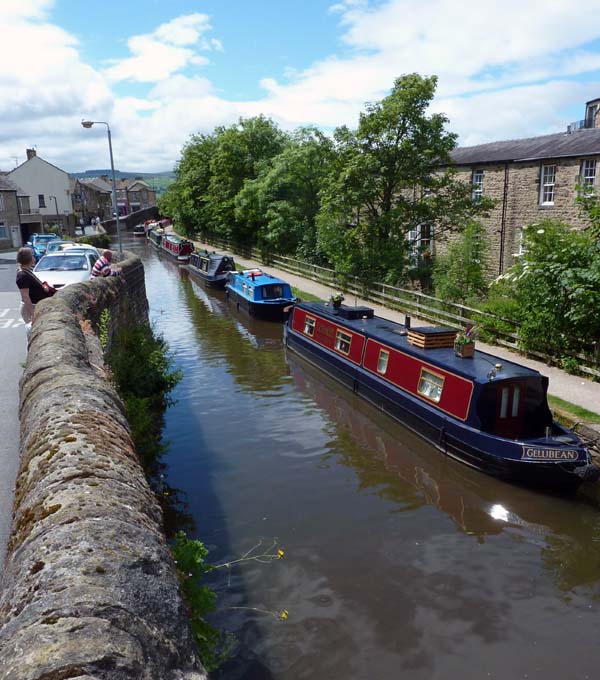 centre of many cities and towns. It was clear hundreds of travellers having caught the travel bug, choosing to either buy or rent one of these crafts to take extended vacations. Others had selected larger, well-appointed river cruise ships with a professional crew to look after the operation, navigation and planning details.
centre of many cities and towns. It was clear hundreds of travellers having caught the travel bug, choosing to either buy or rent one of these crafts to take extended vacations. Others had selected larger, well-appointed river cruise ships with a professional crew to look after the operation, navigation and planning details.
Photo (hdm): While in the town of Foulridge (North Central England) visiting Lynn’s cousins, we observed many narrow canals such as the one in this photo, filled with longboats. In this photo, Lynn stands on the walkway contemplating whether she could handle a year or two of drifting through the countryside.
Many were privately owned live-a-boards but in chatting with a few owners, learned that finding a parking spot was one of the biggest challenges they faced.
Checking in on a few that displayed “For Sale” signs, we found the craft sold in the range of $30,000 to $90,000, about the same as an average motorhome in Canada.
As for where one might travel, it is calculated that in England, Scotland and Wales, there are more than 4,000 kilometers on waterways. Within Europe, Russia and many other countries through the near and far east, the navigable waterways extend to well over 10,000 kilometers. As Garth and I can attest, there is nothing better than taking a leisurely evening cruise down a quietly flowing river with a glass of fine wine in one hand and holding hands with a lovely woman (that would be our wife of course), in the other.
In early 2012, when an opportunity arose to take a Uniworld cruise along the famed Blue Danube, Lynn and I jumped at the chance. (Actually, I preferred to stay home in order to have my morning coffee at Tim Horton’s, then, later, watch the afternoon TV soaps, but Lynn insisted. I am happy that her decision prevailed.)
In addition to the three days stay in Budapest at the beginning of our travels, we also opted to take the four-day tour extension of Prague at the heart of the Czech Republic. It was not long after posting our plans on Facebook that friends Garth and Esther Dunn jumped on board. It was a good match as the Dunn’s are a fun-loving couple willing to step out on a limb to experience new things and to meet new people.
Photo Essay of Budapest
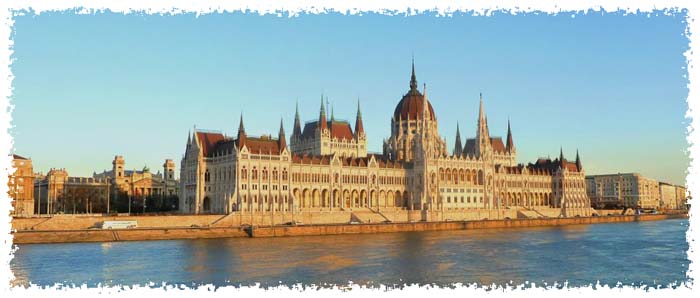
Photo (hdm) Hungarian Parliament Buildings
Over one thousand people were involved in construction, during which 40 million bricks, half a million precious stones and 40 kilograms (88 lb) of gold were used. After World War II the ‘Diet’ became single-chambered and today the government uses only a small portion of the building. During the communist regime a red star perched on the top of the dome, but was removed in 1990. Mátyás Szűrös declared the Hungarian Republic from the balcony facing Lajos Kossuth Square on 23rd October 1989. (web source)
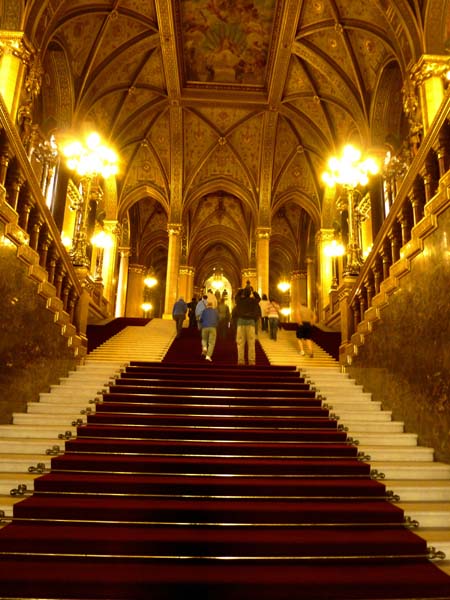
Photo (hdm): This massive staircase leads from the entrance area to a Rotunda under the main dome. With the seemingly endless expanse gold, priceless emeralds, statues and rich colours, the Parliament is exceeded only in lavish richness by some of the Abbey’s and Cathedrals we would later visit. (web source)
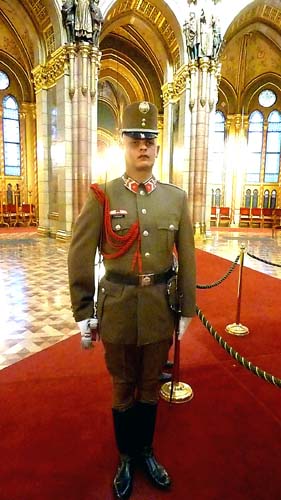
Several guards were stationed in the Main Rotunda. More than once during our tour I was pulled up short by plain clothes guards when I wandered a bit too far from the main tour group.
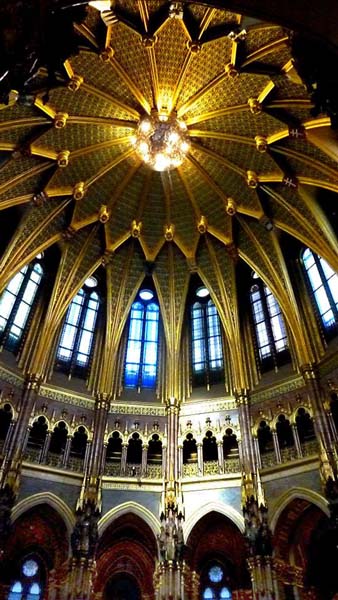
Photo (hdm) It was hard to capture the feeling of expanse this dome provided. It was directly over the display being protected by the above soldier.
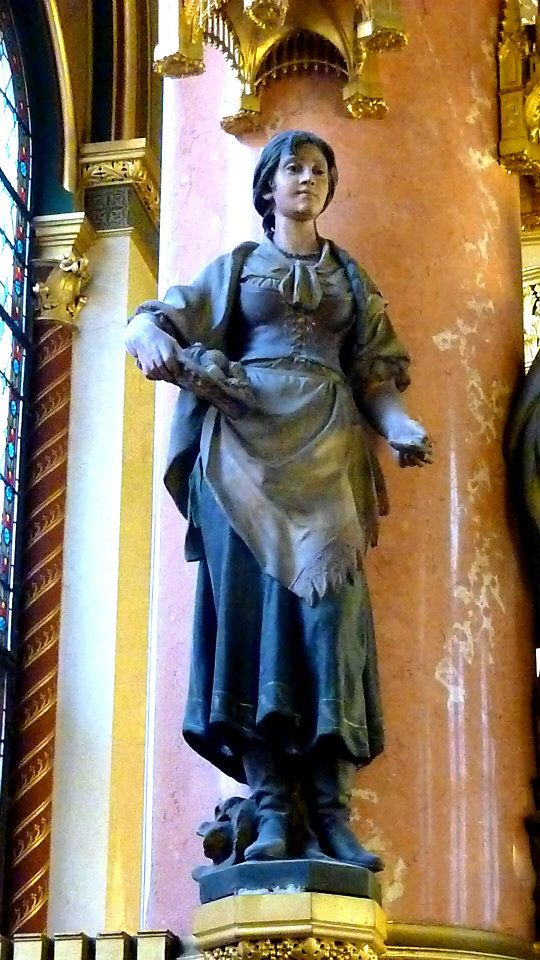
Photo (hdm) One of many life-sized statues that decorate the inside of the
Parliament Buildings.
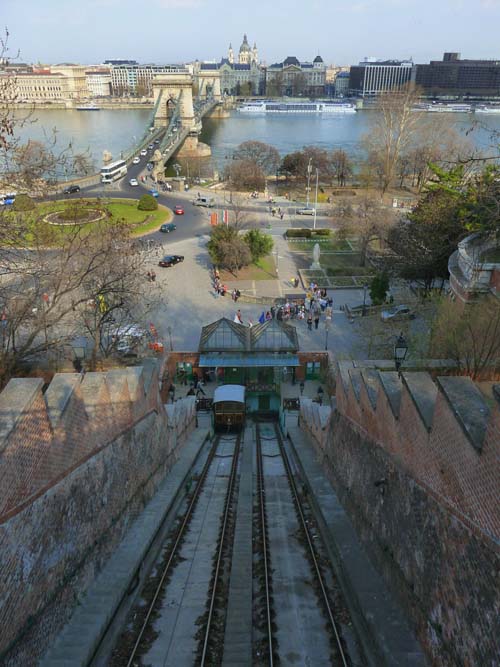
Photo (hdm) View looking down from the Buda Castle and across the river. In the foreground is the funicular. The Chain Bridge is a suspension bridge that spans the River Danube between Buda and Pest. The first bridge across the Danube in Budapest, it was designed by the English engineer William Tierney Clark in 1839, after Count István Széchenyi’s initiative in the same year, with construction supervised locally by Scottish engineer Adam Clark. It opened in 1849, thus became the first bridge in the Hungarian capital. At the time, its centre span of 202 m was one of the largest in the world. The pairs of lions at each of the abutments were added in 1852. It is popular culture in Hungary to point out that the lions, in fact, have no tongues. (Wikipedia)
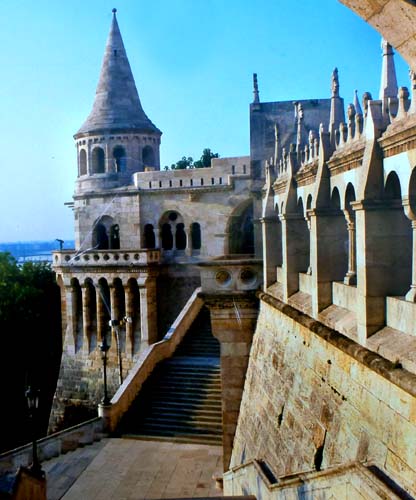
Photo (hdm) From artists concept of the Buda Castle Restoration work.
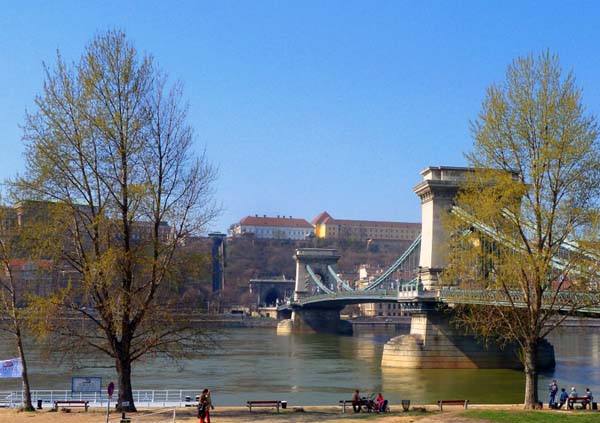
Photo (hdm) Chain Bridge – Another View
Look at the clearance between the bridge and the water – not much room. When the River Beatrice went under bridges such as this the flag mast and all umbrella’s had to be lowered. Passengers on deck had to sit over be knocked over as we skimmed underneath.
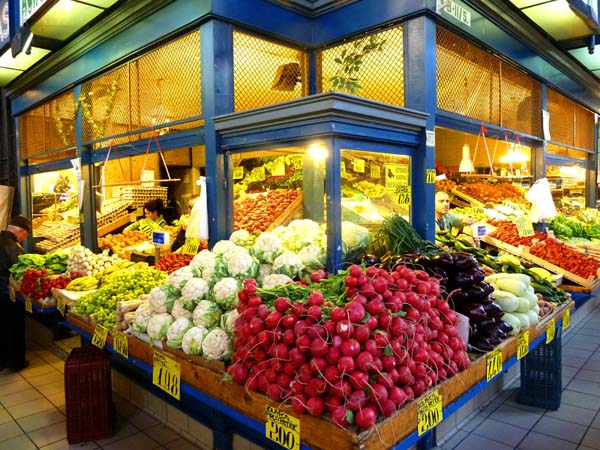
Photo (hdm): Believe it or not, those red vegetables, the size of small turnips, are radishes. This Central Market is located at the end of the six-block, central tourist area through the centre of the city. It is must-see for anyone who enjoys the sights, sounds and smells of markets. There are almost 200 stalls on 3 levels with cafes and restaurants on the top floor. There are stalls with fruit and vegetables, meats and sausages and plenty of souvenirs. In the basement is a supermarket for everyday provisions. The 19th-century architecture is worth the visit even if you are not a shopper. The prices are very competitive by Canadian standards. (Web Source)
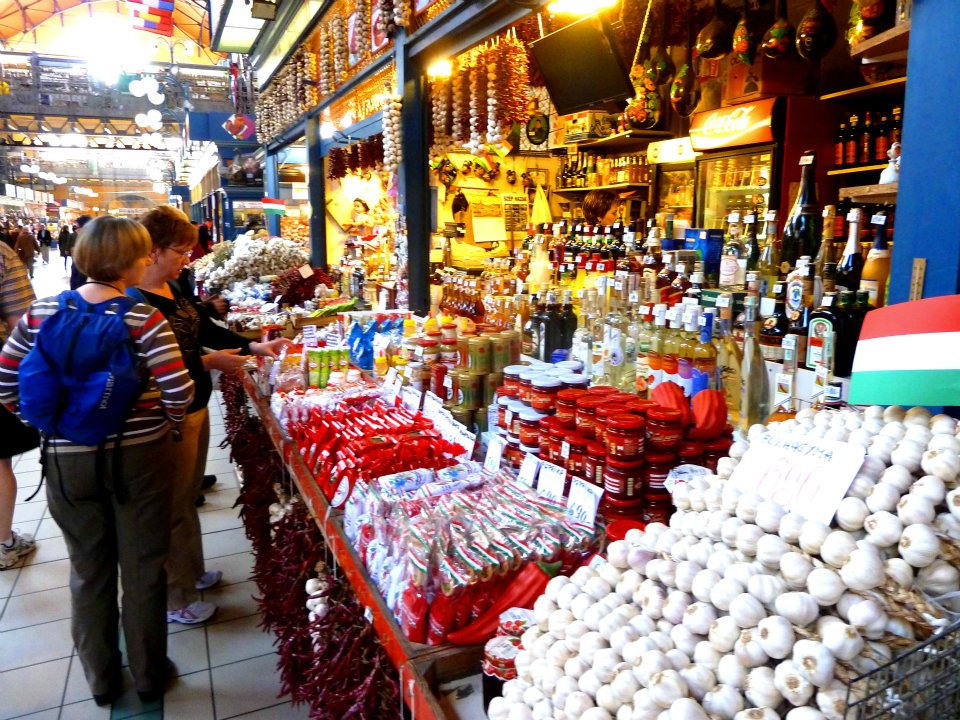
Photo (hdm) Esther and Lynn survey another of the dozens of food displays around the Central Market. I believe the total footage of this market was in the order of 160,000 square feet.
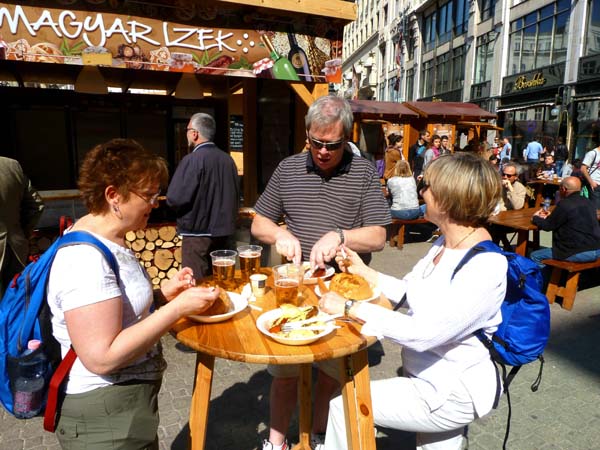
Photo (hdm): This scene was taken a short way into a large Church Cave. A wedding was underway when we entered so I only captured a few photos at the entrance.
Hungary has the best caves in Europe and the Buda hills happen to hold a few of
them in its limestone. Budapest is one of the world’s very few cities where more than 100
caves can be found within the municipal area. The Budapest caves are in the Buda
Mountains situated on the right bank of the Danube, and they are located under residential
districts.
These hydrothermal caves stand in contrast with the simple plan of a
stream cave as these caves are labyrinthine networks of passages. Most of them have
beautiful formations.
The longest cave of Budapest is the Pálvölgyi Cave. The other major cave systems, the
Mátyás-hegyi Cave, Ferenc-hegyi Cave, József-hegyi Cave and Szemlő-hegyi Cave are
also considerable in length and beauty.
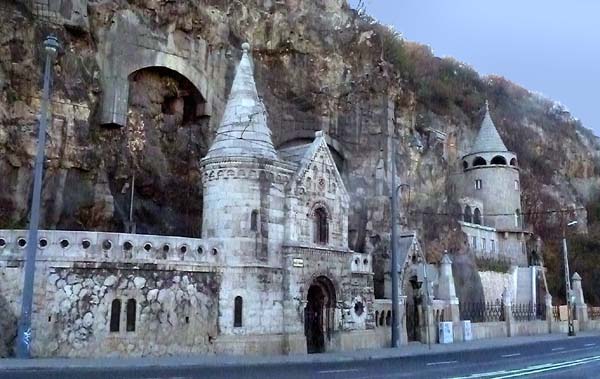 insert
insert
Photo (hdm): These structures sit flush along with one of the main city arterials that run between the Danube directly below the mountain. Behind these structures lie hundreds of connected caves. We simply did not have time to explore all that could be seen in a few short days.
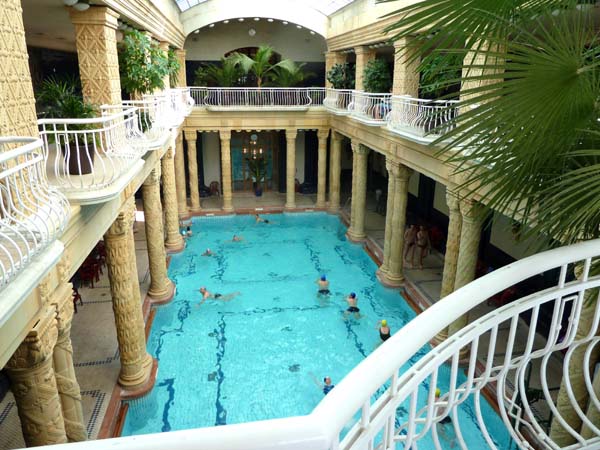
Photo (hdm) Gellért Baths
This immaculately preserved Art Nouveau bath sitting directly below the Church Cave (above) and the hotel was built in 1918, on the site of a previous Turkish bath. The beautiful building is filled with intricate mosaic tiling, stained glass windows, marble columns and statues.
The Gellért complex has a number of small mineral pools, an outdoor swimming pool with artificial waves, a bubbling effervescent pool, a Finnish sauna with plunge pools and massage services (web source). Be prepared to take a little extra cash into the bath as towels and mandatory bathing caps are extra.
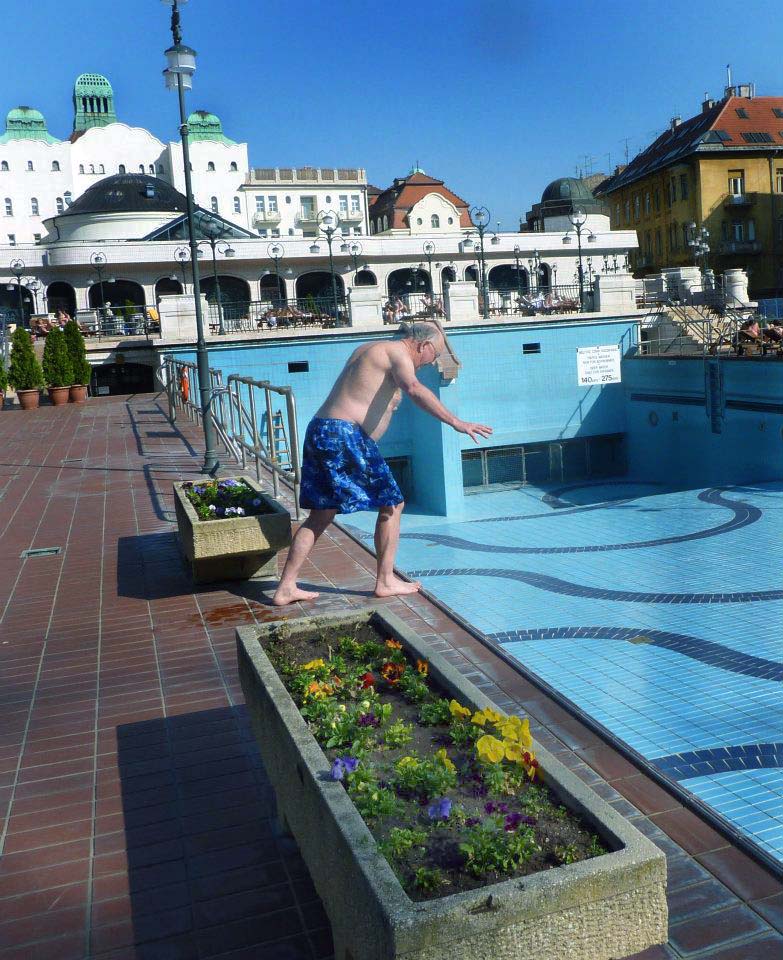
The water in this thermal pool was so clear it was hard to believe no one had entered to soak their ageing bones. Lynn grabbed me just moments before I dove in. She told me to read the sign, something I do not often do. Lucky me.
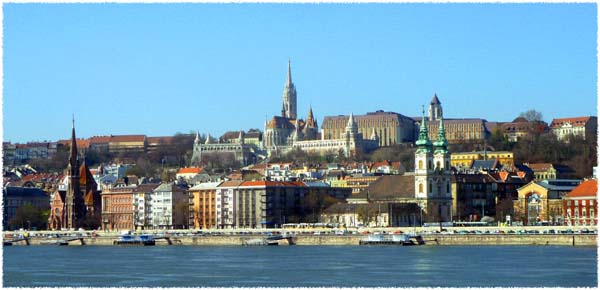
Photo (hdm): Pest side of Budapest taken from our moorage aboard the River Beatrice. Scenes such as this greeted us each and every day of our tour down the Danube.
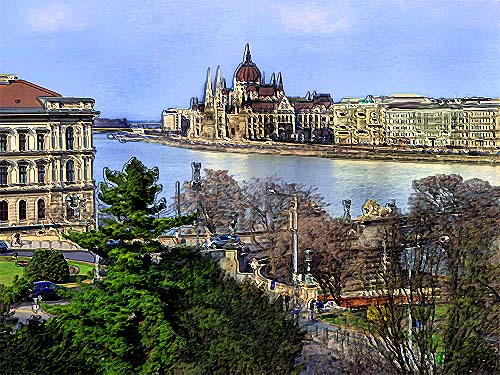
Photo (hdm): A different view of the Danube looking from Buba Castle
(Modified using Photoshop Ink Outline)
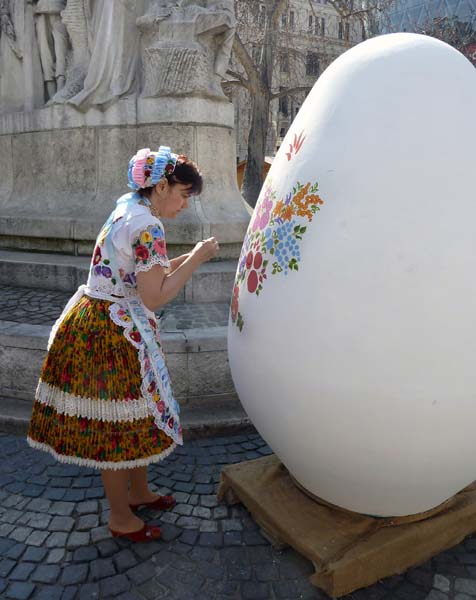
Photo (hdm) With Easter just around the corner, decorating is a very popular pastime in all the countries through which we travelled. Window displays, street scenes and giant Easter Eggs as being coloured by this young woman. When finished, in about two days, this giant egg would be fully covered from top to bottom and around the entire circumference. While the leaves were still waiting for a few more warm days before venturing forth, the colour of Easter filled in the blanks.
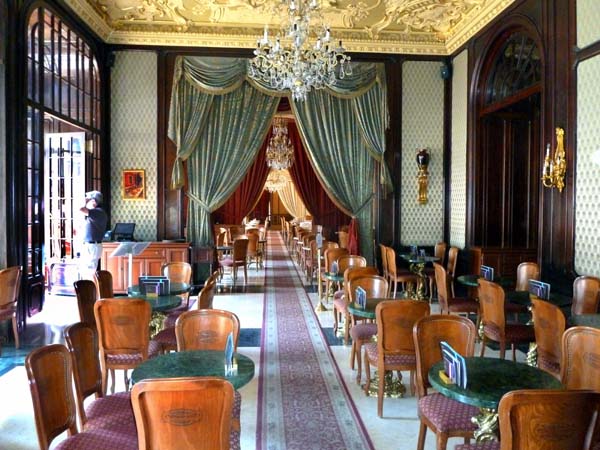
Photo (hdm): Starbucks this is not but it is a coffee shop, the famous Gerbeaud Cafe on Vörösmarty Square in downtown Budapest. An architectural feast for the eyes, it was founded in 1858 and recently celebrated the 150th Anniversary. As the builder, Henrik Kugler didn’t have an heir he sold the cafe to Emil Gerbeaud descendant of a talented Swiss confectioner family. Here Garth is just walking out the door to the main patio area facing the square.(Information from Web)
More photos in the attached album
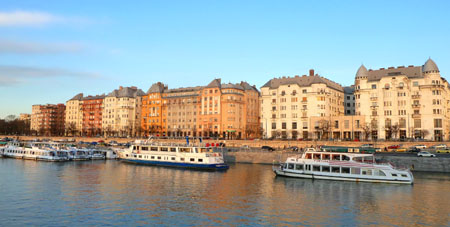
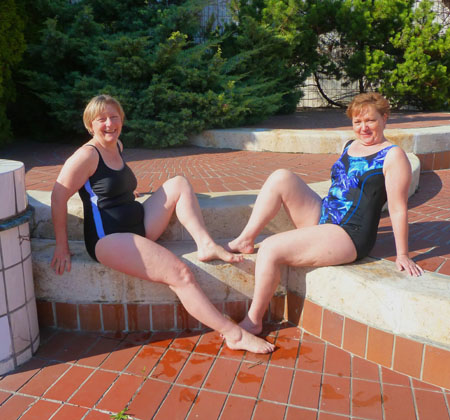
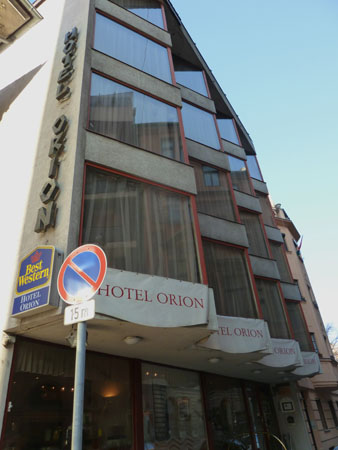
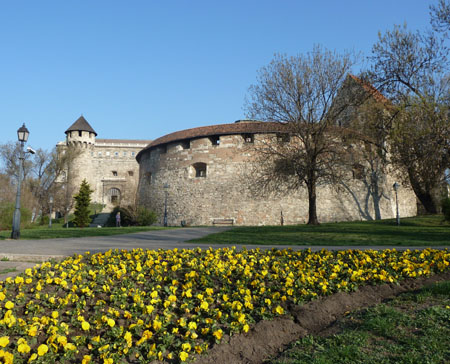
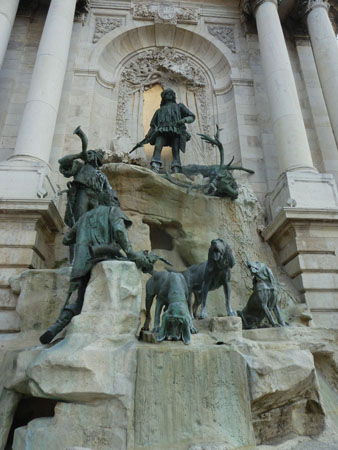
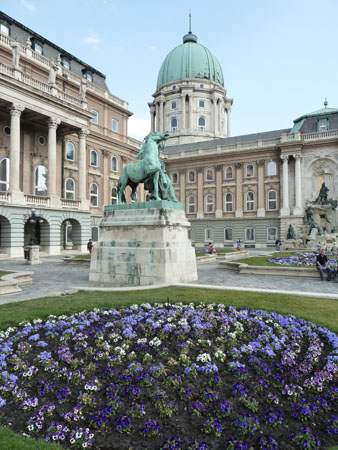
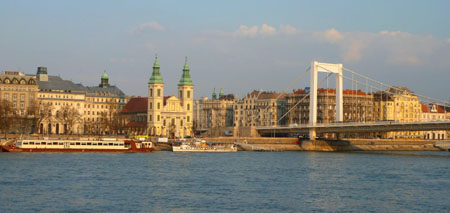
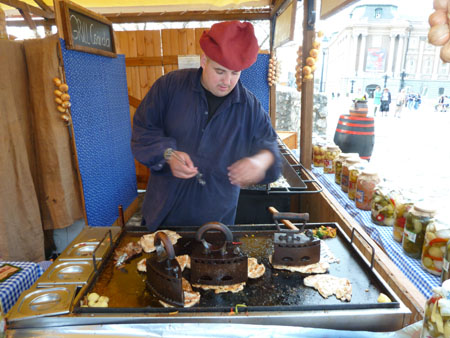
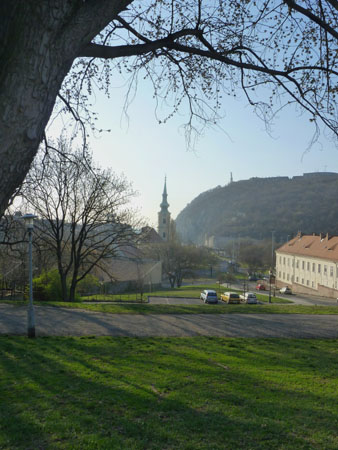
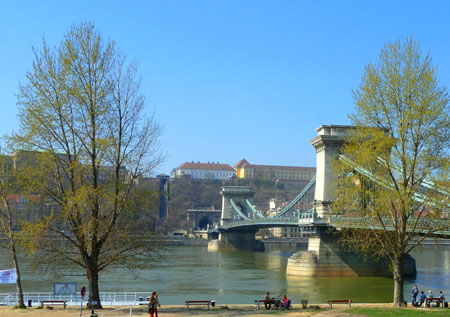
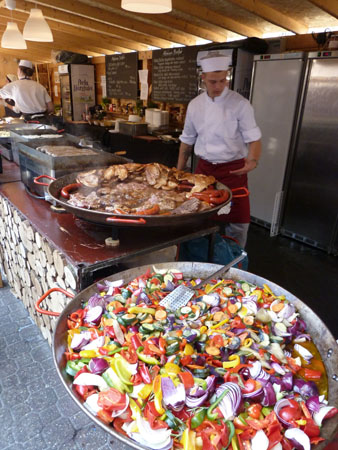
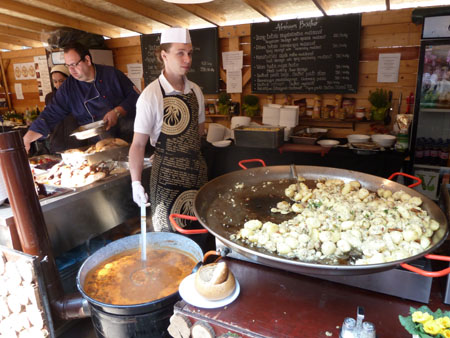
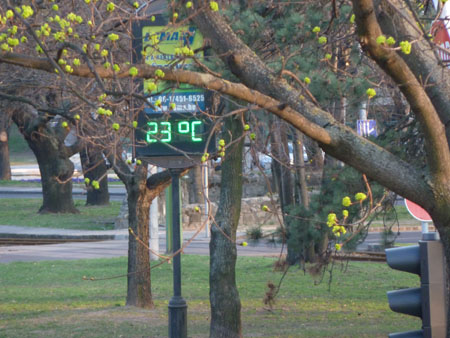
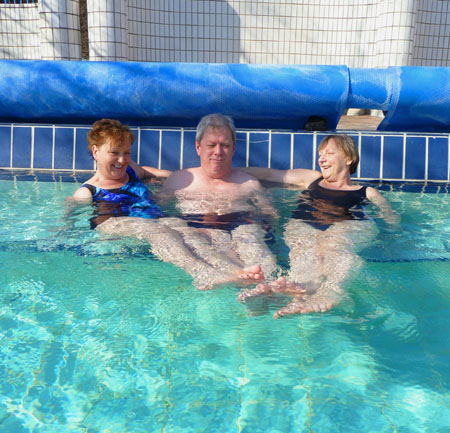
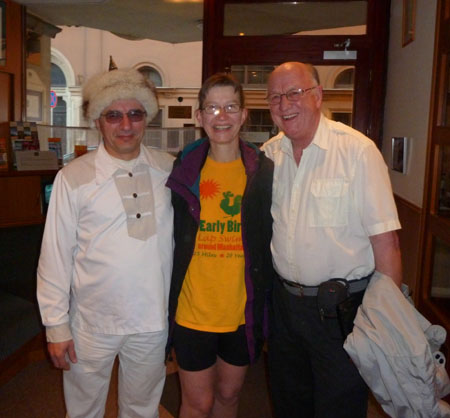
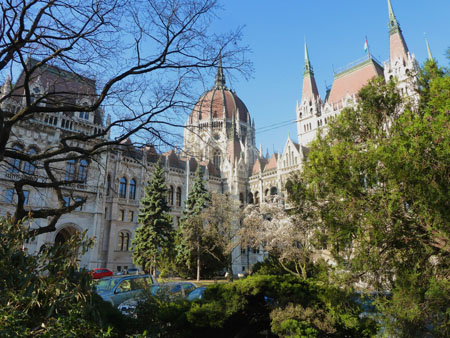
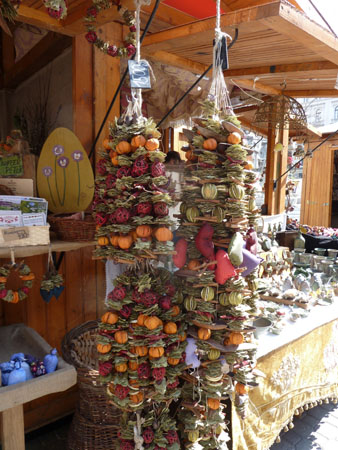
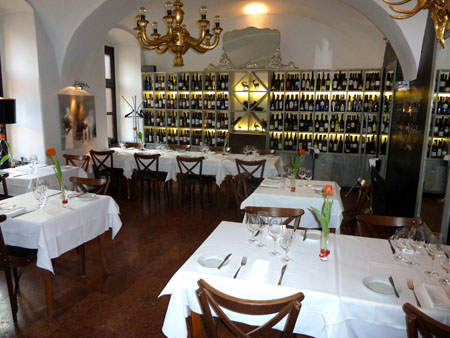
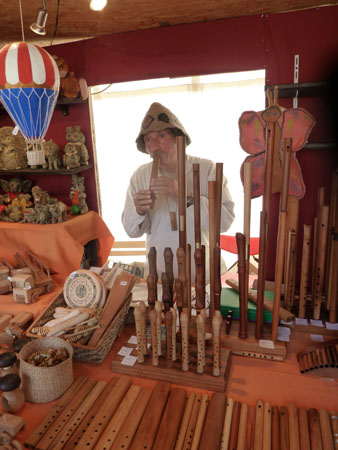
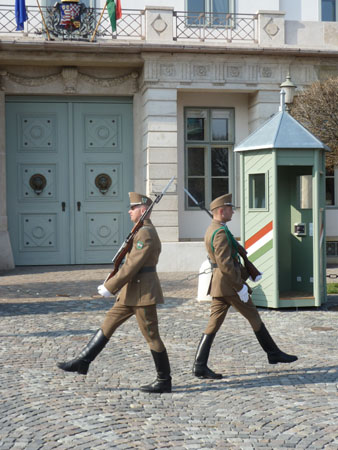
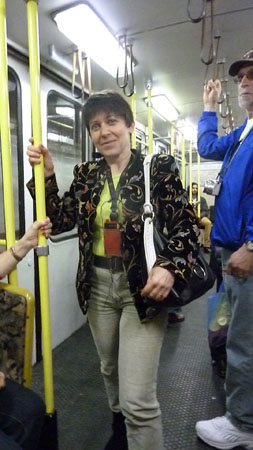
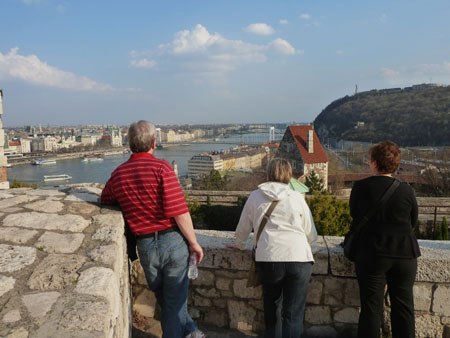
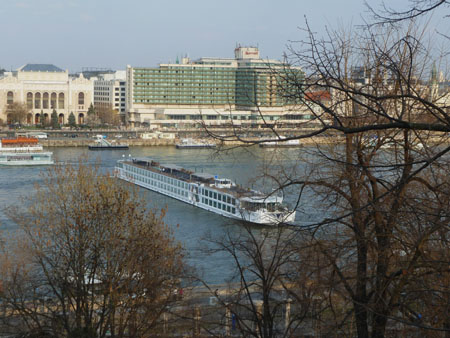
(831)
Tags: Adolf Hitler, Balint Geczy, Barbara Geczy, Buda, Budapest, Garth Dunn, Harold McNeill, Hungarian Freedom Fighters, Hungary, Joseph Calado, Joseph Stalin, Lynn McNeill, Pest, Suzanne Flannigan, Thomas HT Horvath, Uniworld
Trackback from your site.

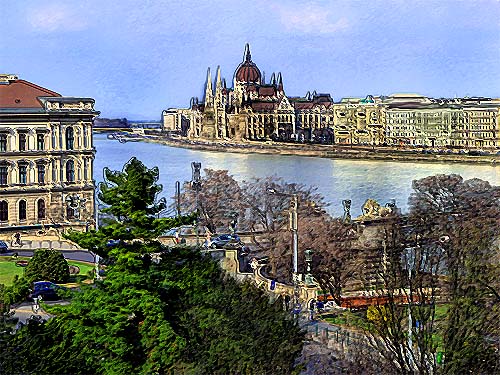
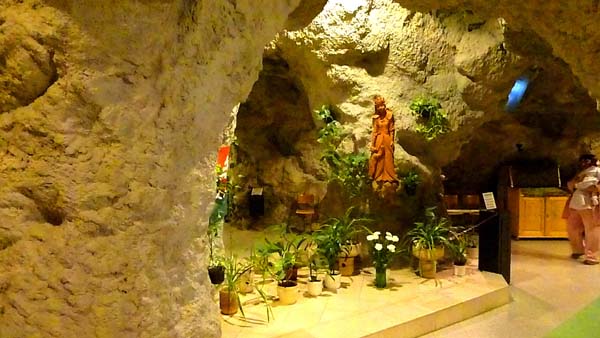
Comments (1)
Wonderful to have the “little extra’s” your research has added to my memories of the trip…Thanks!!